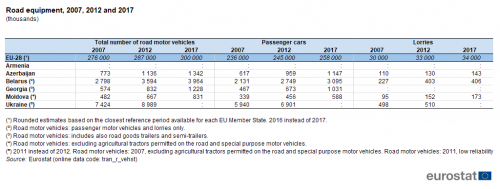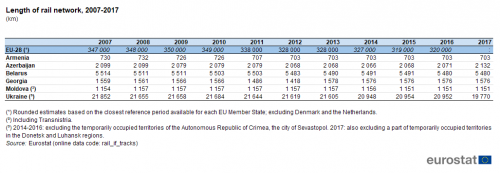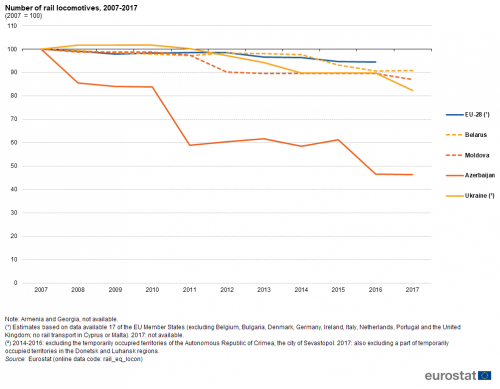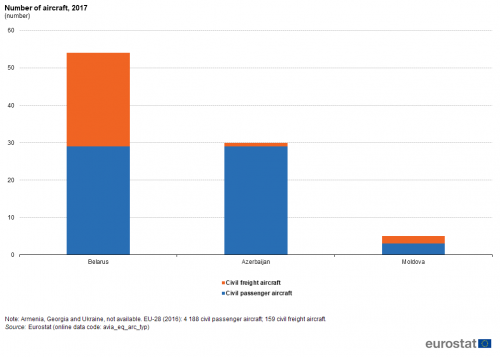Archive:European Neighbourhood Policy - East - transport statistics
Data extracted in December 2018.
Planned article update: January 2020.
Highlights
The ENP-East countries together had a combined road network (including motorways) that was equivalent to almost 8 % of the length of the EU network.
The motorisation rates in the ENP-East countries were considerably lower than the 510 per 1 000 inhabitants rate estimated for the EU: Belarus had the highest rate among the ENP-East countries (for which data are available), at 326 passenger cars per 1 000 inhabitants in 2017.
The combined number of arrivals in the ENP-East countries (excluding Georgia) was 15 million in 2017, which was equivalent to less than 2 % of the EU total. The ENP-East countries recorded much higher growth rates for air passenger arrivals between 2007 and 2017 than did the EU.
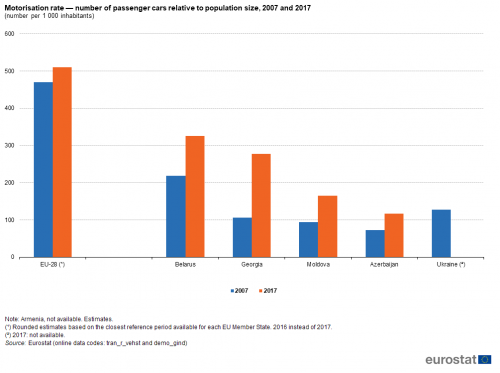
(number per 1 000 inhabitants)
Source: Eurostat (tran_r_vehst) and (demo_gind)
This article is part of an online publication; it presents information on a range of transport statistics for the European Union (EU) and for the six countries that together form the European Neighbourhood Policy-East (ENP-East) region, namely, Armenia, Azerbaijan, Belarus, Georgia, Moldova and Ukraine. Note that data shown in this article for Georgia exclude the regions of Abkhazia and South Ossetia over which the government of Georgia does not exercise effective control and data for Moldova generally exclude Transnistria (see specific footnotes for precise coverage). The latest data for Ukraine generally exclude the territories which are not under the effective control of the Ukrainian government and the illegally annexed Autonomous Republic of Crimea and the City of Sevastopol (see specific footnotes for precise coverage). The article presents a range of transport indicators covering road, rail, air and maritime transport.
Full article
Road transport
There are considerable variations between the ENP-East countries as regards their level of economic development, their total (land) area and population numbers and their geography; hence, it is unsurprising to find wide ranging differences in levels of road infrastructure. Table 1 provides some basic information on the length of road and motorway networks, measured in kilometres (km). In simple terms, a motorway is specially designed and built for motor traffic with separate lanes for two directions, does not serve bordering properties, does not cross at level with any road and is specially sign-posted as a motorway.
Based on the latest available information, the ENP-East countries together had a combined road network (including motorways) that was equivalent to almost 8 % of the length of the EU-28 network. In 2017, the longest road network among the ENP-East countries was recorded in Ukraine (163 thousand km), followed by Belarus (102 thousand km), while the road networks of Moldova (public roads only) and Armenia were less than 10 thousand km in length. Relative to the land area, the density of the road networks was higher in the EU-28 than in the ENP-East countries.
Some areas in the ENP-East countries are sparsely populated and this may, at least to some degree, explain the relatively low level of development of motorway infrastructure. In 2017, the longest motorway network in the ENP-East countries was recorded in Armenia (1.8 thousand km), although it should be noted that these data cover roads that are classified in Armenia as interstate roads and so may not follow the standard definition of a motorway. The motorway networks in Georgia (2016 data) and Ukraine were considerably shorter.
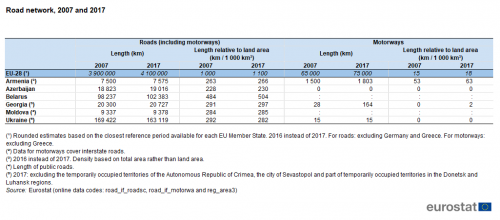
(km)
Source: Eurostat (road_if_roadsc) and (road_if_motorwa)
Among the ENP-East countries, car ownership is usually less commonplace than in the EU and cars tend to account for a lower share of the total number of road vehicles. Subject to data availability, Table 2 shows that Ukraine had the highest total number of passenger cars, at 6.9 million in 2011 (no fresher data available), while the next highest counts (for 2017) were recorded in Belarus (3.1 million), Azerbaijan (1.1 million) and Georgia (1.0 million).
In 2016, the share of passenger cars in the total number of road motor vehicles was estimated to be 86 % in the EU-28. This was slightly higher than the ratios recorded for Azerbaijan (85 % in 2017) and Georgia (84 % in 2017), while the relative importance of passenger cars within the stock of road motor vehicles was lower in the other ENP-East countries (latest data for Ukraine relates to 2011; no data for Armenia).
Among the ENP-East countries, Ukraine (510 thousand, 2011 data) had the highest number of lorries, followed by Belarus (406 thousand, 2017 data).
The motorisation rate (see Figure 1) shows the number of passenger cars relative to the size of the population. Belarus had the highest motorisation rate among the ENP-East countries (for which data are available), at 326 passenger cars per 1 000 inhabitants in 2017, followed by Georgia (277 per 1 000 inhabitants) and Moldova (166 per 1 000 inhabitants). These rates were considerably lower than the 510 per 1 000 inhabitants rate estimated for the EU-28.

(number per 1 000 inhabitants)
Source: Eurostat (tran_r_vehst) and (demo_gind)
Figure 2 presents information on the number of persons killed in road accidents. In the EU-28 there was a marked reduction (approximately 40 %) in the total number of road deaths between 2007 and 2016, as the estimated number of fatalities fell from 43 thousand to 26 thousand. On the basis of the latest information available for the ENP-East countries, there were 5.9 thousand persons killed in road accidents in 2017. More than half of these were killed in Ukraine, where 3.4 thousand persons were killed, while there were fewer than one thousand deaths on the roads of each of the remaining ENP-East countries. Armenia recorded the lowest number of persons killed in road accidents in 2017 among the ENP-East countries (279 deaths).
Overall, there was a marked decrease between 2007 and 2017 in the total number of road deaths in the ENP-East countries; this was particularly true for Ukraine and Belarus, where the total number of people killed in road accidents in 2017 stood at less than 40 % of what it had been a decade earlier. There were also reductions in the number of persons killed in road accidents in the other ENP-East countries for which data are available, although contrary to the situation in Ukraine and Belarus, the pace at which their road deaths were declining was slower than the average decline in the EU-28.
The information presented in the second part of Figure 2 takes account of the population size of each country, dividing the number of people killed in road accidents by the size of the population to give a ratio per 100 000 inhabitants. All of the ENP-East countries recorded higher ratios than the EU-28 (5.0 deaths per 100 000 inhabitants; 2016 data), with this ratio standing at 2.8 times the EU-28 average in Georgia (13.9 deaths per 100 000 inhabitants in 2017).
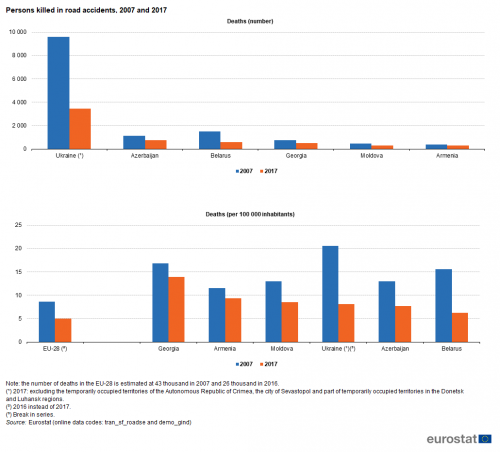
Source: Eurostat (tran_sf_roadse) and (demo_gind)
Rail transport
Capacity is one aspect which may constrain the expansion of rail transport, either in terms of the number/length of railway lines, or the stock of vehicles that are available to transport people and goods. Combining the length of the rail networks for the ENP-East countries in 2017 (see Table 3) gives a length that was equivalent to almost 10 % of the EU-28 network (latest data for the EU-28 relate to 2016), with the longest rail networks in Ukraine (19.8 thousand km) and Belarus (5.5 thousand km).
Between 2007 and 2016, the length of the EU-28 rail network was reduced by approximately 8 %. A reduction of similar magnitude was recorded in Ukraine, where the length of the rail network was reduced by 9.5 % between 2007 and 2017; note that part of this fall may be attributed to a change in geographical coverage. There was a smaller decline in the length of the rail network in Armenia (down 3.7 %), while there was almost no change recorded in Belarus and Moldova (note that the statistics presented for the latter include Transnistria). By contrast, there was a modest expansion in the size of the rail networks of Georgia (1.1 % growth) and Azerbaijan (1.6 %).
An alternative measure of rail capacity is provided by a count of the number of locomotives. These figures — as shown in Figure 3 — highlight a falling level of railway equipment in both the EU and the four ENP-East countries for which data are available (no data for Armenia or Georgia). This was particularly the case in Azerbaijan, where the number of rail locomotives fell by more than half between 2007 and 2016, remaining almost unchanged in 2017. The rate at which the number of rail locomotives fell in Ukraine (down 17.6 % overall during the period 2007-2017; note again the change in geographical coverage), Moldova (-13.0 %) and Belarus (-9.1 %) was also faster than the rate of decline recorded across the 17 EU Member States for which data are available (-5.5 %; 2007-2016).
The total number of rail locomotives was highest in Ukraine (at almost 5 200 in 2017), which was almost seven times as many as in any of the other ENP-East countries for which data are available; the second highest count of rail locomotives was in Belarus (768), which in turn was almost three times as high as the count in Azerbaijan (276).
Table 4 presents a set of indicators for analysing rail passenger and rail freight developments. There were 245 million passengers carried on the rail networks of the six ENP-East countries in 2017. Between 2007 and 2017 the number of rail passengers fell in each of the ENP-East countries, with the largest declines recorded in Azerbaijan, Ukraine (note that there is a break in series) and Moldova.
Rail freight services provide an alternative to road freight transport and are generally considered as more environmentally friendly. However, rail services may be constrained by the extent to which the rail network covers a country. Within the EU-28 there was a 15 % reduction in rail freight during the period from 2007 to 2016. The quantity of rail freight carried in the ENP-East countries also fell between 2007 and 2017, except in Belarus where there was an overall increase of 4 % in rail freight. By contrast, rail freight fell by approximately half in Azerbaijan, Ukraine (note that part of this fall may be attributed to a change in geographical coverage) and Georgia (data refer to the national territory and abroad), while the decline in Moldova was even greater at 71 %.
Passenger-kilometres (pkm) and tonne-kilometres (tkm or tonne-km) are also used for analysing transport statistics. On this basis, there was confirmation that rail passenger transport fell during the period 2007-2017 in most of the ENP-East countries. The only exception was Armenia, where despite a 37 % fall in the overall number of passengers, the number of pkm travelled more than doubled (an increase of 132 %), signifying a considerable increase in the average length of journeys.
In a similar vein, the quantity of rail freight transport — measured in tonne-km — was also lower in 2017 than in 2007 in the EU-28 (an overall decline of 10 %; 2007-2016) and all but one of the ENP-East countries. The exception was Belarus, where the quantity of rail freight rose marginally (up 1 %). At the other end of the range, the quantity of freight carried by rail fell by more than half in Azerbaijan, Georgia (data refer to the national territory and abroad) and Moldova.
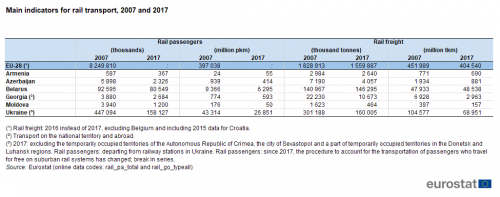
Source: Eurostat (rail_pa_total) and (rail_go_typeall)
Air transport
There has been considerable expansion in air services in recent decades, both in terms of passenger numbers and freight carried. Although there has been rapid growth, it is worthwhile noting that the weight of goods carried by air is relatively low, given the high cost of this mode of transport (for example, when compared with maritime freight) especially for bulky items.
In 2016, there were 298 airports in the EU-28 with more than 150 000 passengers per year. For ENP-East countries principal airports are defined as those recording more than 1.5 million passenger equivalents per year (a passenger equivalent is a passenger or 100 kg of freight or mail): there were relatively few principal airports in the ENP-East countries (subject to data availability), the highest count being recorded in Azerbaijan (six). Given the considerable investment required for building a new airport and the relatively lengthy lead-in times for construction, it is perhaps not surprising to find that there was no change in the number of principal airports between 2007 and 2017 in Georgia (three) or Belarus (one). However, the number of principal airports in Azerbaijan doubled during the period under consideration, rising from three to six.
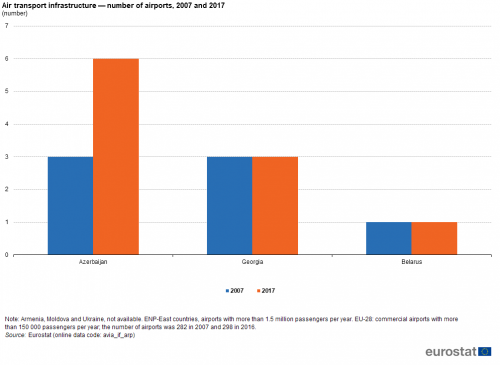
(number)
Source: Eurostat (avia_if_arp)
The count of the number of aircraft is based on civil aircraft registered in each country and configured for the transport of passengers (including their baggage and freight, including mail) or freight (solely for the carriage of freight and/or mail). Figure 5 provides information as to the composition of the civil fleet. In 2016, there were almost 4 200 passenger aircraft in the EU-28 and a further 159 freight aircraft. Among the ENP-East countries (no data for Armenia, Georgia and Ukraine), Belarus and Azerbaijan both had fleets of 29 passenger aircraft in 2017. It is interesting to note that the number of freight aircraft in Belarus was almost as high (at 25), which was atypical when compared with the other ENP-East countries and the EU Member States.
Table 5 presents two main indicators for air transport, the number of passenger arrivals and the quantity of air freight and mail arrivals. In 2017, there were 830 million air passenger arrivals in the EU-28. The combined number of arrivals in the ENP-East countries (excluding Georgia) was 15 million, which was equivalent to less than 2 % of the EU-28 total. The highest number of air passenger arrivals among the ENP-East countries was registered in Ukraine (8.2 million), followed by Azerbaijan (2.4 million).
The number of EU-28 air passenger arrivals increased overall by 31 % between 2008 and 2017. All of the ENP-East countries for which data are available (no data for Georgia) recorded much higher growth rates for air passenger arrivals between 2007 and 2017, although from relatively low initial levels. The most rapid expansion was recorded for Moldova and Belarus, where air passenger arrivals were approximately five times as high in 2017 as they had been 10 years earlier.
The quantity of air freight and mail arrivals was highest among the ENP-East countries in Azerbaijan, reaching 234 thousand tonnes in 2017 (no data for Belarus or Georgia). This marked a considerable expansion when compared with just five years earlier (79 thousand tonnes in 2012). The quantity of air freight and mail arrivals was at a much lower level in the remaining ENP-East countries and showed little change during the most recent 10-year period for which data are available.

Source: Eurostat (avia_paoc) and (avia_gooc)
Maritime transport
No maritime transport data are presented in this article for Armenia, Belarus or Moldova, all of which are landlocked.
A principal port is defined as a port handling more than one million tonnes of cargo or recording more than 200 000 passenger movements each year. In 2017, there with eight principal ports in Ukraine (note this excludes the temporarily occupied territories of the Autonomous Republic of Crimea and the city of Sevastopol), six in Azerbaijan and three in Georgia.
Figure 7 provides information on the number of merchant ships registered in each of the ENP-East countries; it is important to note that it is relatively common for merchant ships to sail under a flag of convenience (whereby a ship can be registered to another country and therefore is not included in the statistics presented here). In 2017, there were more than 3 thousand merchant vessels in Ukraine (note that the geographical coverage and the data refer to vessels of all sizes), compared with just 50 vessels in Azerbaijan (of 300 grt and over).
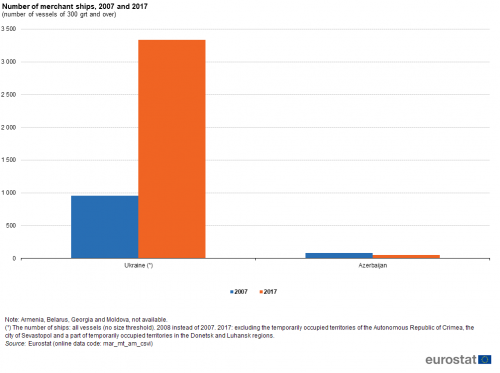
(number of vessels of 300 grt and over)
Source: Eurostat (mar_mt_am_csvi)
The final table in this article presents some main indicators for maritime passenger and freight transport. In 2016, there were almost 200 million passengers carried by maritime services in the EU-28; this marked a fall of almost 10 % when compared with the situation in 2007. Data are only available for two of the ENP-East countries, Azerbaijan and Ukraine. The former has a relatively low level of maritime passenger activity but higher levels of maritime freight, with Baku on the Caspian Sea playing an important role regarding Europe-Asia transit routes. During the last decade there was a dramatic reduction in both the number of maritime passengers carried and the quantity of maritime freight carried in Ukraine. Both of these developments may be linked to political tension between Ukraine and Russia, which may have impacted on the lower passenger numbers arriving in Black Sea ports, while trade sanctions/embargos between Ukraine and Russia from 2014 onwards may explain (some of) the subsequent reduction in maritime trade. Note also that the data for 2017 exclude the temporarily occupied territories of the Autonomous Republic of Crimea and the city of Sevastopol.

Source: Eurostat (mar_mp_aa_cphd) and (mar_mg_aa_cwhd)
Source data for tables and graphs
Data sources
The data for ENP-East countries are supplied by and under the responsibility of the national statistical authorities of each country on a voluntary basis. The data that are presented in this article result from an annual data collection cycle that has been established by Eurostat. These statistics are available free-of-charge on Eurostat’s website, together with a range of different indicators covering most socio-economic areas.
For the EU-28, transport statistics are available with an annual frequency and generally begin in the early 1990s. Eurostat’s statistics describe the most important features of transport, not only in terms of the quantities of freight and numbers of passengers that are moved each year, or the number of vehicles and infrastructure that are used, but also the contribution of transport services to the economy as a whole. Data collection is supported by several legal acts obliging the EU Member States to report statistical data (framework legislation and implementing legislation, organised according to the mode of transport under consideration), as well as voluntary agreements to supply additional data.
Passenger transport statistics
The majority of passenger transport statistics are based on vehicle movements in each of the reporting countries, regardless of the nationality of the vehicle or vessel involved (the ‘territoriality principle’). For this reason, the measure of passenger-kilometres (pkm, which represents one passenger travelling a distance of one kilometre) is generally considered as a more reliable measure, as a count of passengers entails a higher risk of double-counting, particularly for international transport. A rail passenger is any person, excluding members of the train crew, who makes a journey by rail. Air transport statistics concern national and international transport, as measured by the number of passengers carried; information is collected for arrivals and departures. A sea passenger is defined as any person that makes a sea journey on a merchant ship; service staff are excluded, as are non-fare paying crew members travelling but not assigned, as well as infants in arms.
Eurostat publishes transport safety data for road, rail, inland waterways and air transport. CARE is the European centralised database on road accidents which result in death or injury across the EU, developed on the basis of Council Decision 93/704/EC; it is managed by the Directorate-General for Mobility and Transport. A road death is defined as a death that is caused by a road accident and which occurs within 30 days from the date of the accident; the count includes drivers and passengers in motorised vehicles and on bicycles who might be involved in road accidents, as well as pedestrians.
Freight transport statistics
As with passenger transport statistics, freight transport statistics are generally based on movements in each reporting country, regardless of the nationality of the vehicle or vessel involved (the ‘territoriality principle’). For this reason, the measure of tonne-kilometres (tkm or tonne-km, in other words, one tonne of goods travelling a distance of one kilometre) is generally considered a more reliable measure when analysing freight transport statistics, as the simple use of tonnes entails a higher risk of double-counting, particularly for international transport. The weight of goods transported by rail is the gross-gross weight. This includes the total weight of the goods, all packaging, and the tare weight of the container, swap-body and pallets containing goods; it also includes road goods vehicles that are carried by rail. By contrast, the weight measured for maritime and road freight transport is the gross weight (in other words, excluding the tare weight).
Tables in this article use the following notation:
| Value in italics | data value is forecasted, provisional or estimated and is therefore likely to change; |
| : | not available, confidential or unreliable value; |
| – | not applicable. |
Context
An efficient and well-functioning passenger and freight transport system is vital for enterprises and inhabitants. The ability to move goods safely, quickly and cost-efficiently to markets is important for international trade, national distributive trades, and economic development. The rapid increase in international trade up to the onset of the global financial and economic crisis and the deepening integration of the EU’s single market, alongside a range of economic practices (including the concentration of production in fewer sites to reap economies of scale, delocalisation, and just-in-time deliveries), may explain — at least to some degree — developments in the volume of freight being transported.
The European Commission’s Directorate-General for Mobility and Transport is responsible for developing transport policy within the EU. It aims to develop policy to foster clean, safe and efficient travel throughout Europe, underpinning the internal market for goods (transferring them between their place of production and consumption) and the right of citizens to travel freely throughout the EU (for both work and pleasure).
On 18 November 2015, the High Representative for Foreign Affairs and Security Policy and the European Commission jointly presented a review of the European Neighbourhood Policy (SWD(2015) 500 final) which underlined a new approach for the EU in relation to its eastern and southern neighbours, based on stabilising the region in political, economic, and security-related terms.
In cooperation with its ENP partners, Eurostat has the responsibility ‘to promote and implement the use of European and internationally recognised standards and methodology for the production of statistics, necessary for developing and monitoring policy achievements in all policy areas’. Eurostat undertakes the task of coordinating EU efforts to increase the statistical capacity of the ENP countries. Additional information on the policy context of the ENP is provided here.
Direct access to
- All articles on non-EU countries
- All articles on transport
- European Neighbourhood Policy countries — statistical overview — online publication
- Statistical cooperation — online publication
Books
Leaflets
- Basic figures on the European Neighbourhood Policy — East countries — 2018 edition
- Basic figures on the European Neighbourhood Policy — East countries — 2016 edition
- Basic figures on the European Neighbourhood Policy — East countries — 2015 edition
- Basic figures on the European Neighbourhood Policy — East countries — 2014 edition
- International trade for the European Neighbourhood Policy — East countries — 2016 edition
- European Neighbourhood Policy-East countries — Statistics on living conditions — 2015 edition
- European Neighbourhood Policy — East countries — Key economic statistics — 2014 edition
- European Neighbourhood Policy — East countries — Labour market statistics — 2014 edition
- European Neighbourhood Policy — East countries — Youth statistics — 2014 edition
- Transport (enpr_tr)
- ENP countries: transport (enpr_transp)
- Transport, see:
- Railway transport (rail)
- Road transport (road)
- Maritime transport (mar)
- Air transport (avia)
- Illustrated glossary for transport statistics — 4th edition
- Eastern European Neighbourhood Policy countries (ENP-East) (ESMS metadata file — enpr_esms)
